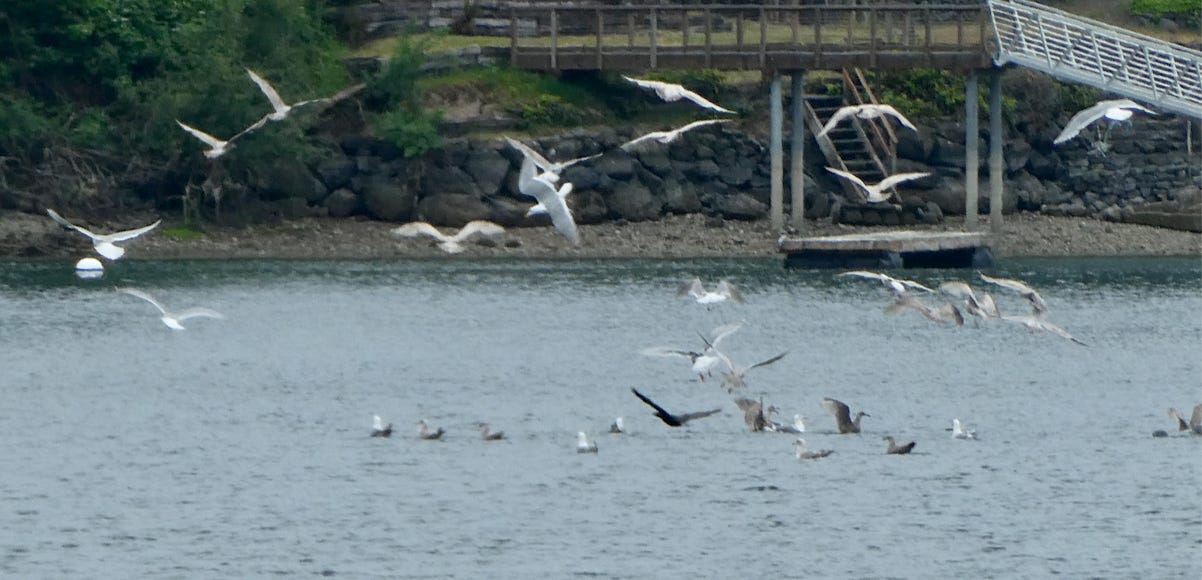Look out over the beautiful blue surface of Puget Sound and you get little inkling of the life beneath. But every once in a while a sign appears, providing insight to the incredible bounty that makes the waterway such an amazing ecosystem. I had this happen last week at the north end of Case Inlet. Dozens of gulls were swarming over the water, calling and flapping, clearly excited. Amidst the bird’s diving were seals moving swiftly through the water, periodically popping above the surface. Although I couldn’t see what brought these animals together, I knew what they sought. Below the surface had to be a baitball, or a gathering of fish, most likely herring or sand lance.
Both species are known as forage fish, basically high fat, fast foods for other animals, and arguably some of Puget Sound’s most critical food resources. When alarmed by a predator, such as harbor seals and common murres, herring and sand lance form tight swirls of thousands of fish; the chances of any individual being eaten go way down when in the mob. One local predator, rhinoceros auklets (named for the horn on their stocky bills), actively generate baitballs by diving below the fish and generating “killer bubbles” that herd the fish. Individual auklets then shoot through the ball for a well deserved meal. Other eaters also take advantage of the auklets’ skills to feed at the fish round up.
The first time I learned about baitballs I was in a 14-foot Zodiac rubber boat on Admiralty Inlet with USGS biologist Jake Gregg. We were hoping to catch fish in one of the baitballs so Jake could examine the fish for viruses. Our plan was to look for gull swarms and when we saw one, speed into the group, and slam to a stop. I would then plunge a net on a ten-foot-pole into the shimmering ball. The first time I did this the net brought up what Jake estimated to be 3,000 to 4,000 sand lance. A subsequent catch was at least two, perhaps three times, larger. Jake though needed herring for his research so all our effort was for naught but at least we got to crisscross Admiralty Inlet in a small boat.
Although we didn’t catch any herring that day the sand lance did provide a window into the pulses of life that course underwater out of our normal sight. My little net caught only 5,000 or so fish; imagine the total that must be swimming throughout the Sound. So, next time you are looking out on Puget Sound (or another body of salt water) and see gulls and/or other birds in some sort of frenzy, think of them as an x-ray providing you a view into the inner workings and lives within the water.
Herring in Puget Sound - Every year the Washington Department of Fish and Wildlife monitors when and where herring spawn. This year was a decent one with large spawning events in Quilcene Bay and Port Orchard-Port Madison, as well as at Purdy. Erin Jaco, who reports on the spawning, told me, “we’ve had more pleasant surprises than disappointments with our stocks,” which is good news for herring and Puget Sound. If you are interested in learning more about herring, I can recommend Homewaters. My mom says it’s a good read.
Well, it’s that semi-yearly time when I reach out to readers to ask for your financial support for my newsletter. As always, the benefits to you are priceless: the good feeling of knowing you are encouraging the spread of my dorkability; the thrill of reading exciting words such as endozoochory, parboiled pease, perjink, and tombolo; and the joy of knowing that you make my day because of your support and encouragement. Plus, I trust you enjoy the newsletters, too. By the way, the monthly cost for a paid subscription is about what you pay for a gallon of gasoline. C’mon, which provides a better value?
Word of the week - Pacific herring (Clupea pallasii) - The specimen that inspired the scientific name was collected in Kamchatka in the 1730s or 1740s; acquired by German zoologist Peter Simon Pallas later in the century; bequeathed upon his death to his Swedish friend, Karl Rudolphi; then given to the German director of the Berlin Zoological Museum, Martin H.C. Lichenstein; who provided the fish to French ichthyologist, Achille Valenciennes; who finally published his description in 1847. By contrast and with remarkable dullness, Clupeus, or shield, is simply a reference to the scales covering the body.






Loved this piece!
Just to enliven your Thursday, here's a quote from John Keast Lord, The Naturalist in Vancouver Island and British Columbia (1866):
I have often seen a shoal of herrings, when hotly pursued by the dogfish, dash into a little rock-bound nook, the water lashed into white spray by a thousand tails and fins, plied with all the power and energy the poor struggling fish could exert to escape the dreaded foe. A wall of rocks, right and left, ahead the shelving shingle—on they go, and hundreds lie high-and-dry, panting on the pebbles. It is just as well perhaps to die there, as to be torn, bitten, and eaten by the piratical cannibals that are waging the fearful havoc on the imprisoned shoal. The dogfish wound ten times as many as they eat, and, having satiated and gorged their greedy stomachs, swim lazily away, leaving the dead, dying, and disabled to the tender mercies of the sea-birds watching the battle, ever ready to pounce upon the unprotected, and end its miseries.
Yours in herring,
Boyd